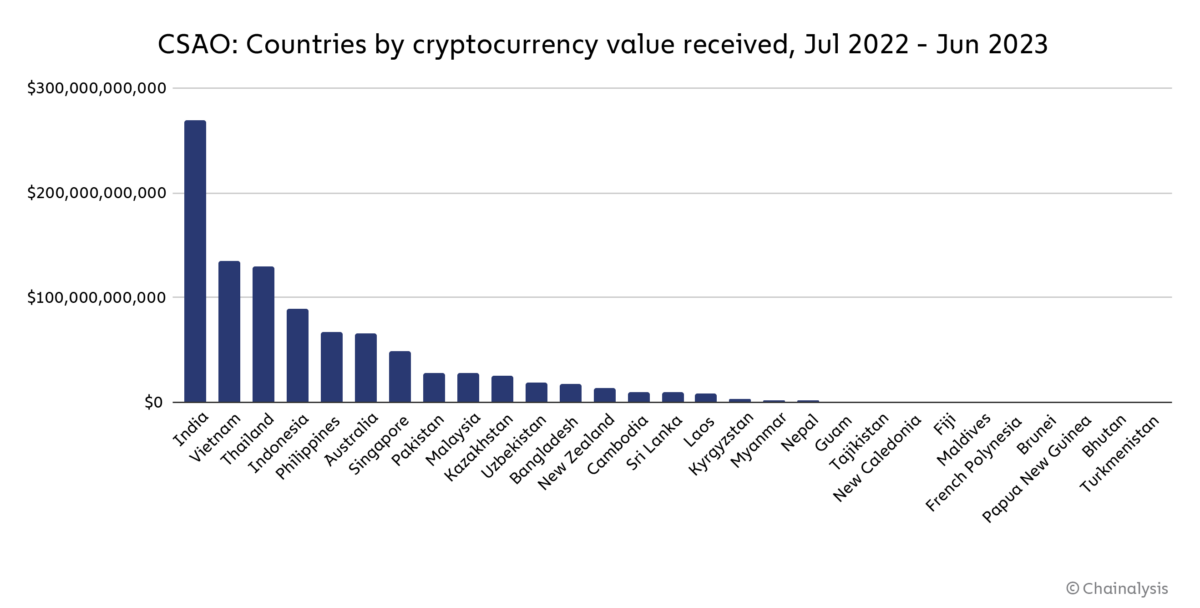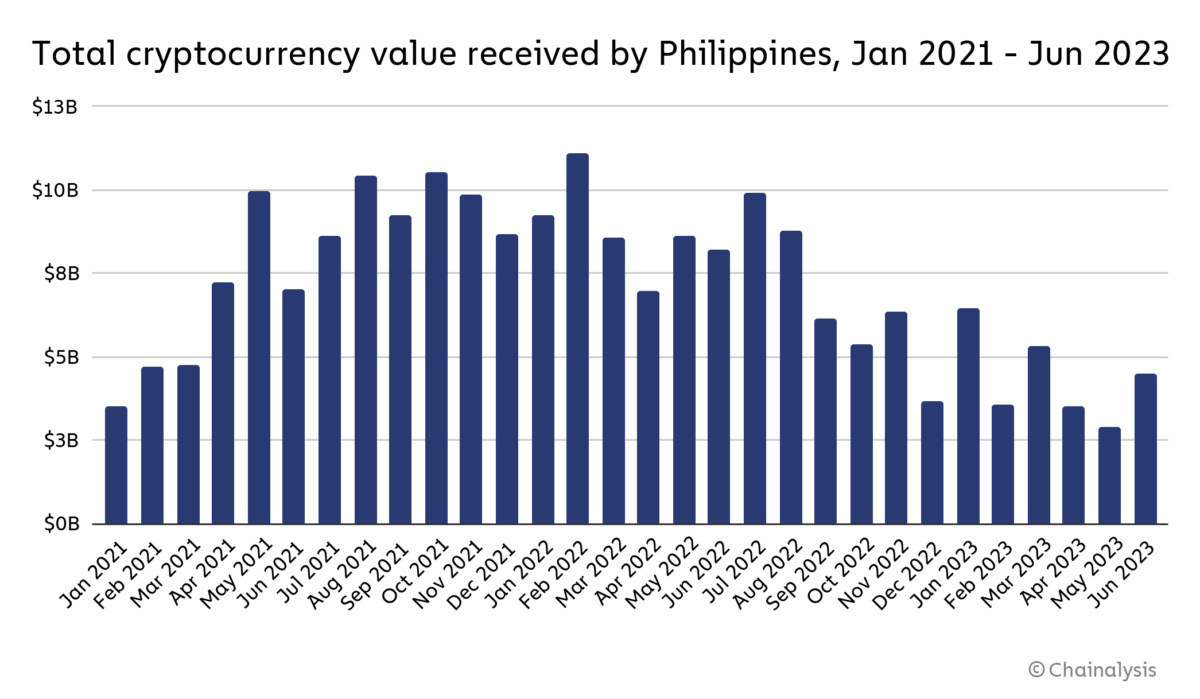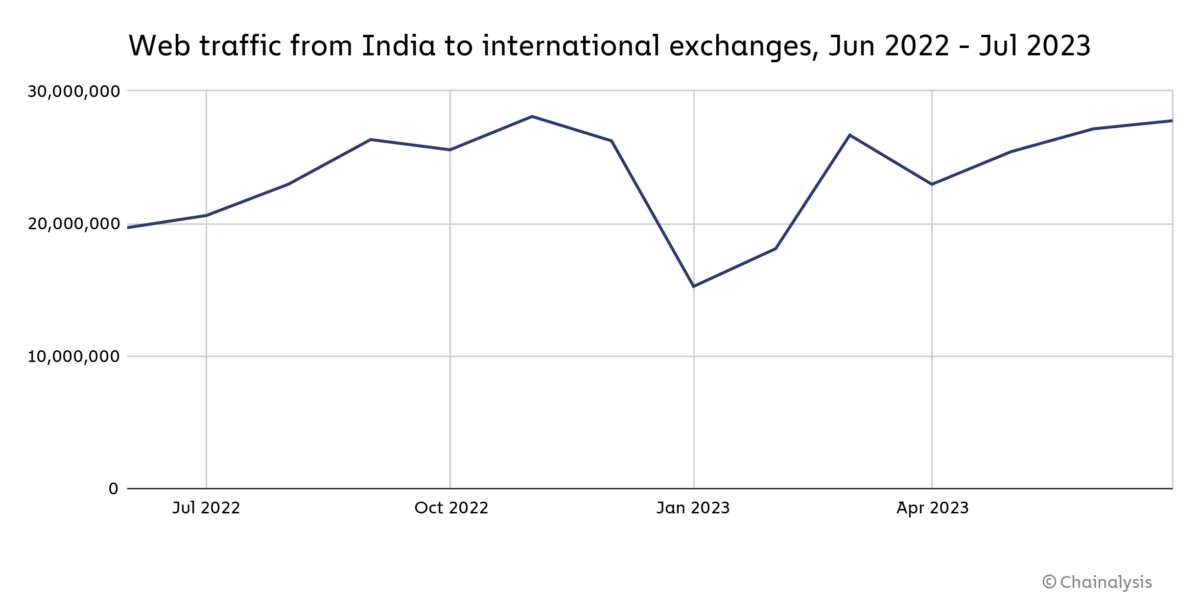Chainalysis report: Large-scale application of cryptocurrency in India, Philippines and Pakistan
Original title: Is Central & Southern Asia the Future of Crypto? Here’s What Drives Crypto Usage in the Region Leading the Way in Grassroots Adoption.》
Original author: Chainalysis
Central Asia, South Asia and Oceania (CSAO) has the most dynamic and attractive cryptocurrency markets in the world. Central Asia and Oceania is the third largest cryptocurrency market we studied by raw trading volume, behind North America and Central, Northern and Western Europe (CNWE), accounting for less than 20% of global trading volume.


India leads the way in terms of trading volume, receiving approximately $268.9 billion in crypto assets during the study period.

However, raw trading volume doesnt tell the whole story. When we consider purchasing power and population to measure grassroots adoption, CSAO dominates. We see this in the Global Cryptocurrency Adoption Index, with six of the top ten countries located in the region: India (1), Vietnam (3), Philippines (6), Indonesia (7), Pakistan (8) and Thailand (10). In addition, DeFi played a more important role in CSAO last year, with DeFi estimated to account for 55.8% of the region’s trading volume between July 2022 and June 2023, compared with 35.2% in the same period a year earlier. Institutional adoption also appears to be on the rise in the region, with 68.8% of total transaction volume coming from transfers worth $1 million or more, compared to 57.6% in the previous period.


But importantly, CSAO is not a monolith when it comes to cryptocurrency adoption. Factors driving cryptocurrency adoption vary across CSAO countries, leading to varying rates of usage of different types of cryptocurrency services. We can see this in the chart below, which shows a breakdown of network traffic for different types of cryptocurrency platforms in the CSAO countries with the highest adoption index.

In all these countries, centralized exchanges account for the majority of web traffic, and this is also the case globally. However, we see significant differences elsewhere as well. For example, a large portion of cryptocurrency-related web traffic in the Philippines goes to gaming and gambling platforms, accounting for 19.9%, followed by Vietnam with only 10.8%. At the same time, countries such as Pakistan and Vietnam have a higher share of P2P exchange activity, and these exchanges are more commonly used in emerging markets or countries with stricter capital controls.
Below, we explore the different adoption drivers in two CSAO countries, the Philippines and Pakistan, and examine how these differences lead to different usage patterns. Then, we’ll look at some of the latest trends in India, a country that leads the world in grassroots cryptocurrency adoption.
The Axie Infinity craze kicked off cryptocurrency adoption in the Philippines, but what happens next?
Cryptocurrency enthusiasts have long viewed the $217 billion video game industry as an area where cryptocurrencies can have a positive impact, such as allowing players to earn, buy and sell in-game items. Weve seen a number of ambitious projects take on this problem, with varying degrees of success, and no country has embraced them as much as the Philippines, which has been particularly captivated by money-making game Axie Infinity. To find out more, we spoke with Donald Lim, a veteran in Philippine advertising and marketing who has worked across multiple industries and has now entered the world of cryptocurrencies as Chairman of the Philippine Blockchain Council The first Chairman and the main organizer of Philippine Blockchain Week.
“I think Axie Infinity is the moment when cryptocurrencies really come to the Philippines,” Lim said. While the game is most popular among the younger generation, Lim sees people from all walks of life playing it. You get on a tricycle and you see the driver with his phone on top of the windshield, playing Axie - there are so many stories like that. In fact, the Philippines accounts for the largest share of total Axie Infinity network traffic, reaching At 28.3%, on-chain data shows that the growth in cryptocurrency trading volume in the country coincides with the growth of Axie in the summer of 2021.

What makes the Philippines so receptive to play and earn games like Axie Infinity? Lim has several reasons. First, the Philippines has a group of tech-savvy young people who have accepted fiat digital wallets such as GCash. When Axie Infinity launched and began to gain popularity, the world was in the midst of the COVID pandemic and many people were stuck at home and without work — Axie provided a way for people to have fun and make extra cash. It also provides a social outlet for people. Filipinos are accustomed to struggling to connect online and through social media because, as a country made up of many small islands, we are inherently isolated. We are also the largest exporter of human capital in the world, and Filipinos abroad want to connect with those at home. people to connect with,” Lim explains. According to him, the high usage of social media in the Philippines makes it easier for the game to go viral and reach users through strategies such as influencer marketing.
Since then, Axie Infinitys overall usage and token prices have plummeted, and many people in the Philippines and elsewhere who have given up on the game are no better off financially than before. But the game’s success set the stage for further cryptocurrency adoption, as many Filipinos who played the game now have wallets that can be used for other purposes.
Lim believes the best way to turn the initial momentum into beneficial cryptocurrency applications is for regulators and large online companies to step up. “Cryptocurrency adoption can’t just be bottom-up. Governments need to set the rules and the largest companies need to incorporate cryptocurrencies into their products.” Positive momentum is already emerging on both fronts. The Philippine government has designated a special economic zone in the Bataan region where cryptocurrency companies setting up shop can enjoy tax incentives and operate in a regulatory sandbox designed to foster innovation. On the private sector side, Philippine Airlines recently launched a utility-driven NFT series that allows users to enjoy special perks, while Philippine financial services company Cebuana Lhuillier announced an integration with the Stellar blockchain to provide faster and cheaper Remittance Services – This is crucial for a country like the Philippines that receives a lot of money from abroad.
Lim firmly believes that the Philippines has the ability to become a leader in the cryptocurrency space. “We can become the blockchain capital of Asia. Look at the developer talent, look at all the online groups dedicated to trading and NFTs — it’s just a matter of time.”
In Pakistan, demand drives the adoption of cryptocurrencies, especially stablecoins. Although Pakistan’s overall transaction volume is lower, it leads the world in grassroots cryptocurrency adoption, not far behind the Philippines. But the adoption patterns in the two countries are quite different. Social connections and speculation have prompted many Filipinos to enter the cryptocurrency field through play and earn games, while the need for wealth preservation in the face of high inflation and currency depreciation appears to be the reason why many Pakistanis are turning to cryptocurrencies. We spoke with Zeeshan Ahmed, Pakistan General Manager of well-known cryptocurrency exchange Rain, to find out more. Rain operates in several countries in the region and does not currently have any commercial activities in the country as cryptocurrency trading is currently prohibited under Pakistani law, but it is working towards one day obtaining regulatory licenses.
When we asked Ahmed what is driving cryptocurrency adoption in Pakistan, he gave some sobering data. Five years ago, Pakistans inflation rate was 10.6%. Now, the officially reported inflation rate is 29.4%, but in reality it is much higher. The main spike is that in the past 16 months, the value of the rupee has gone from PKR 178 per USD in January 2022 fell to PKR 320 in August.” Unfortunately, Pakistan’s dire economic situation means savings can be eroded quickly. Beyond that, there aren’t many good investment options for ordinary people in the current environment. Stock markets and stock exchanges have collapsed. Any gains you make can be wiped out by inflation, Ahmed explained. Pakistani citizens are also prohibited from holding physical foreign currency—foreign currency must be deposited in a bank. For many, this makes cryptocurrencies, especially stablecoins, a necessity. This is our only hedging option.
Equally important, on-chain data doesn’t tell the whole story about cryptocurrency adoption in a country like Pakistan. Much of the country’s transaction volume, especially the acquisition of stablecoins, occurs through informal peer-to-peer markets and is not easily identifiable on-chain. Therefore, it is difficult to know exactly how many people are holding or acquiring cryptocurrency at any given time. In addition, experts speculate that businesses in Pakistan use stablecoins such as USDT to import goods from abroad to hedge against inflation and currency devaluation, but this is difficult to confirm.
Although cryptocurrency trading is officially banned in Pakistan, Ahmed believes that a clear regulatory framework can help make the cryptocurrency market more productive for Pakistani citizens. While the official position has not changed, Ahmed said he sensed some recent progress on that front. Eight months ago, our regulators didnt even want to talk about cryptocurrencies. But as recently as July of this year, we submitted a white paper to them on how to regulate cryptocurrencies, and they seem to be moving forward. For example, the future Regulations may allow Pakistanis to move funds from bank accounts to exchanges, which would make it easier and more cost-effective for them to acquire the digital assets they need, setting the stage for further growth.
Despite tax law difficulties, India remains top cryptocurrency market
While other markets in the region are dynamic and can help us understand the unique drivers of cryptocurrency adoption, the largest CSAO cryptocurrency market by far is India. According to our Global Crypto Adoption Index, India leads the world in grassroots adoption, but even more impressively, India has become the world’s second-largest crypto by raw estimated transaction volume currency markets, beating out several wealthier countries.

Cryptocurrency usage in India spans several different forms of activity, with India ranking in the top 10 for usage across different categories of cryptocurrency services.
Perhaps most impressively, India emerged as a top cryptocurrency market despite its regulatory and tax environment being challenging for the industry. Last year, the regulator provided greater clarity on a number of issues, for example, formally ordering that its money laundering rules would apply to cryptocurrency trading. However, India imposes a much higher tax rate on cryptocurrency activity than most other countries, with a 30% tax on gains — a rate specific to cryptocurrencies and higher than the country’s tax on other investments such as stocks — levied on all transactions. The 1% tax, also known as Tax Deduction at Source (TDS), means that cryptocurrency platforms must deduct the amount from a user’s balance at the time of transaction in order to complete the transaction.
Further corroborating recent reports, industry players in the region have told us that uneven implementation of TDS could make it harder for local exchanges to compete. While every exchange operating in India is required to collect TDS tax from Indian users, many international exchanges do not do this effectively, which may attract Indian users rather than exchanges that are primarily focused in India. We can see some evidence of this in the chart below, which shows a surge in network traffic from India to international exchanges immediately after the implementation of TDS in July 2022.

This trend highlights the importance of strict enforcement of local rules such as TDS by all exchanges operating in a given country. Otherwise, it will create an environment of regulatory arbitrage and harm the country’s domestic crypto industry.
However, while these issues are important, they don’t seem to be dampening India’s huge demand for cryptocurrencies — as long as demand exists, cryptocurrencies will have a place in the world’s second-largest country.
CSAO shows cryptocurrencies can adapt to local conditions
No region has more reason to believe cryptocurrencies are the future than CSAO, and not just because so many CSAO countries in the region are among the best in grassroots adoption. This is because these countries have broad and unique economic needs, and different cryptocurrency platforms and assets have emerged to meet these needs. In the Philippines, where many people want to speculate on new assets, earn extra cash, and connect digitally with others, the “play for cash” game has taken hold. These games are an entry point into the broader digital asset economy, and thousands of Filipinos now have cryptocurrency wallets that can be used for other purposes. In Pakistan, where the economic situation is even more dire—considering Pakistan’s PPP per capita is $5,680 compared to the Philippines’ $9,210, combined with the currency depreciation we’ve described—stablecoins are providing economic relief. If the Pakistani government passes sensible cryptocurrency regulations, its existing users will be the basis for a prosperous cryptocurrency market, as we have seen in India. CSAO demonstrates that cryptocurrencies have a valuable role to play, regardless of a country’s national circumstances.



